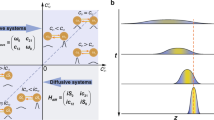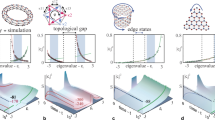Abstract
Topological phases have been studied in photonic, acoustic and phononic metamaterials, promising a range of applications. Such topological modes usually stem from collective resonant effects in periodic lattices. One may, therefore, expect similar features to be forbidden for thermal diffusion that is purely dissipative and mostly incoherent, prohibiting collective resonances. Here we report the discovery of diffusion-based topological states supported by spatiotemporally modulated advections stacked over a fluidic surface. This arrangement imitates a periodic propagating potential in an effective thermal lattice. We observe edge states in topologically non-trivial and bulk states in topologically trivial lattices. Interface states form at boundaries between these two types of lattice, manifesting inhomogeneous thermal properties on the fluidic surface. Our findings establish a framework for topological diffusion and thermal edge or bulk states, and it may allow a distinct mechanism for the flexible manipulation of diffusive phenomena for robust heat and mass transfer.
This is a preview of subscription content, access via your institution
Access options
Access Nature and 54 other Nature Portfolio journals
Get Nature+, our best-value online-access subscription
$29.99 / 30 days
cancel any time
Subscribe to this journal
Receive 12 print issues and online access
$209.00 per year
only $17.42 per issue
Buy this article
- Purchase on Springer Link
- Instant access to full article PDF
Prices may be subject to local taxes which are calculated during checkout




Similar content being viewed by others
Data availability
Source data are provided with this paper. All other data that support the plots within this paper and other findings of this study are available from the corresponding author upon reasonable request.
References
Yang, Y. et al. Realization of a three-dimensional photonic topological insulator. Nature 565, 622–626 (2019).
Lustig, E. et al. Photonic topological insulator in synthetic dimensions. Nature 567, 356–360 (2019).
Zilberberg, O. et al. Photonic topological boundary pumping as a probe of 4D quantum Hall physics. Nature 553, 59–62 (2018).
Liu, Y. et al. Bulk–disclination correspondence in topological crystalline insulators. Nature 589, 381–385 (2021).
Stützer, S. et al. Photonic topological Anderson insulators. Nature 560, 461–465 (2018).
Shen, H., Zhen, B. & Fu, L. Topological band theory for non-Hermitian Hamiltonians. Phys. Rev. Lett. 120, 146402 (2018).
Ghatak, A. & Das, T. New topological invariants in non-Hermitian systems. J. Phys.: Condens. Matter 31, 263001 (2019).
Feng, L., El-Ganainy, R. & Ge, L. Non-Hermitian photonics based on parity–time symmetry. Nat. Photon. 11, 752–762 (2017).
Wang, K. et al. Generating arbitrary topological windings of a non-Hermitian band. Science 371, 1240–1245 (2021).
Khanikaev, A. B. et al. Photonic topological insulators. Nat. Mater. 12, 233–239 (2013).
Chen, Z. & Segev, M. Highlighting photonics: looking into the next decade. eLight 1, 2 (2021).
Hokmabadi, M. P., Schumer, A., Christodoulides, D. N. & Khajavikhan, M. Non-Hermitian ring laser gyroscopes with enhanced Sagnac sensitivity. Nature 576, 70–74 (2019).
Hadad, Y., Soric, J. C., Khanikaev, A. B. & Alu, A. Self-induced topological protection in nonlinear circuit arrays. Nat. Electron. 1, 178–182 (2018).
Leykam, D., Bliokh, K. Y., Huang, C., Chong, Y. D. & Nori, F. Edge modes, degeneracies, and topological numbers in non-Hermitian systems. Phys. Rev. Lett. 118, 040401 (2017).
Xu, H., Mason, D., Jiang, L. & Harris, J. G. E. Topological energy transfer in an optomechanical system with exceptional points. Nature 537, 80–83 (2016).
Doppler, J. et al. Dynamically encircling an exceptional point for asymmetric mode switching. Nature 537, 76–79 (2016).
Lin, Z. et al. Unidirectional invisibility induced by \(\mathcal {PT}\)-symmetric periodic structures. Phys. Rev. Lett. 106, 213901 (2011).
Peng, B. et al. Parity-time-symmetric whispering-gallery microcavities. Nat. Phys. 10, 394–398 (2014).
Peng, B. et al. Loss-induced suppression and revival of lasing. Science 346, 328–332 (2014).
Zhao, H. et al. Topological hybrid silicon microlasers. Nat. Commun. 9, 981 (2018).
Zhao, H. et al. Non-Hermitian topological light steering. Science 365, 1163–1166 (2019).
Zeng, Y. et al. Electrically pumped topological laser with valley edge modes. Nature 578, 246–250 (2020).
Bandres, M. A. et al. Topological insulator laser: experiments. Science 359, eaar4005 (2018).
Harari, G. et al. Topological insulator laser: theory. Science 359, eaar4003 (2018).
Choi, J. H. et al. Room temperature electrically pumped topological insulator lasers. Nat. Commun. 12, 3434 (2021).
Bahari, B. et al. Nonreciprocal lasing in topological cavities of arbitrary geometries. Science 358, 636–640 (2017).
Liang, G. Q. & Chong, Y. D. Optical resonator analog of a two-dimensional topological insulator. Phys. Rev. Lett. 110, 203904 (2013).
Takata, K. & Notomi, M. Photonic topological insulating phase induced solely by gain and loss. Phys. Rev. Lett. 121, 213902 (2018).
Li, M., Ni, X., Weiner, M., Alù, A. & Khanikaev, A. B. Topological phases and nonreciprocal edge states in non-Hermitian Floquet insulators. Phys. Rev. B 100, 45423 (2019).
Liertzer, M. et al. Pump-induced exceptional points in lasers. Phys. Rev. Lett. 108, 173901 (2012).
Feng, L., Wong, Z. J., Ma, R. M., Wang, Y. & Zhang, X. Single-mode laser by parity-time symmetry breaking. Science 346, 972–975 (2014).
Yoon, J. W. et al. Time-asymmetric loop around an exceptional point over the full optical communications band. Nature 562, 86–90 (2018).
Xia, S. et al. Nontrivial coupling of light into a defect: the interplay of nonlinearity and topology. Light Sci. Appl. 9, 147 (2020).
Xia, S. et al. Nonlinear tuning of PT symmetry and non-Hermitian topological states. Science 372, 72–76 (2021).
Liu, S. et al. Gain- and loss-induced topological insulating phase in a non-Hermitian electrical circuit. Phys. Rev. Appl. 13, 014047 (2020).
Gao, H. et al. Non-Hermitian route to higher-order topology in an acoustic crystal. Nat. Commun. 12, 1888 (2021).
Li, Y. et al. Anti–parity-time symmetry in diffusive systems. Science 364, 170–173 (2019).
Fan, C. Z., Gao, Y. & Huang, J. P. Shaped graded materials with an apparent negative thermal conductivity. Appl. Phys. Lett. 92, 251907 (2008).
Han, T. et al. Experimental demonstration of a bilayer thermal cloak. Phys. Rev. Lett. 112, 054302 (2014).
Zhou, X., Xu, G. & Zhang, H. Y. Binary masses manipulation with composite bilayer metamaterial. Compos. Struct. 267, 113866 (2021).
Zhou, X. & Xu, G. Self-adaptive field manipulation with thermal logic material. Int. J. Heat Mass Trans. 172, 121147 (2021).
Xu, G. et al. Tunable analog thermal material. Nat. Commun. 11, 6028 (2020).
Torrent, D., Poncelet, O. & Batsale, J.-C. Nonreciprocal thermal material by spatiotemporal modulation. Phys. Rev. Lett. 120, 125501 (2018).
Acknowledgements
C.-W.Q. acknowledges financial support from the Ministry of Education, Republic of Singapore (grant no. R-263-000-E19-114). A.A. acknowledges financial support from the Office of Naval Research with grant no. N00014-19-1-2011, the Vannevar Bush Faculty Fellowship, the Air Force Office of Scientific Research with MURI grant no. FA9550-18-1-0379 and the Simons Foundation. Y.Y. and H.C. acknowledge the National Natural Science Foundation of China (NNSFC) under grant nos. 61625502, 61975176, 11961141010 and 62175215; the Top-Notch Young Talents Program of China; and the Fundamental Research Funds for the Central Universities. X.Z. acknowledges financial support from the Chongqing Natural Science Foundation (grant no. cstc2021jcyj-msxmX0627) and the Science and Technology Research Program of Chongqing Municipal Education Commission (grant no. KJQN202000829).
Author information
Authors and Affiliations
Contributions
G.X. and C.-W.Q. conceived the idea. G.X., X.Z. and C.-W.Q. proposed the methodology. G.X., Y.Y., H.C., A.A. and C.-W.Q. performed the theoretical derivations. G.X. and X.Z. implemented the experimental investigations. G.X., Y.Y., X.Z. and C.-W.Q. made the visualizations. G.X., Y.Y., H.C., A.A. and C.-W.Q. performed the theoretical analysis and wrote the manuscript. C.-W.Q. supervised the work. All the authors contributed to the discussion and to finalizing the manuscript.
Corresponding author
Ethics declarations
Competing interests
The authors declare no competing interests.
Peer review
Peer review information
Nature Physics thanks Muamer Kadic and the other, anonymous, reviewer(s) for their contribution to the peer review of this work.
Additional information
Publisher’s note Springer Nature remains neutral with regard to jurisdictional claims in published maps and institutional affiliations.
Extended data
Extended Data Fig. 1 The entire structure and experimental setups.
a indicates the entire structure for implementing advections (effective oscillations) on the fluid surface, a constraint shell is adopted outside the fluid surface to keep the concentric rotations for each unit and the internal gear. During the measurements, this constraint shell is removed to directly capture the temperature-related data of the fluid surface. b and c present the fabricated dynamic components and their combinations consisting of 40 internal gear sets for modulating the fluid surface. The azimuthal direction of the units is marked in (b). The black dashed border in (c) indicates the region for IR images when fluid is coated on these dynamic components, while the interval of two neighboring deriving gears on a transmission shaft is 4a. The black dot marked with ‘1’ indicates the first unit of the entire system at the initial location of z = 0. d provides the real experiment setups, and the left upper inset presents the general engagement of the internal gear set for one unit cell. The colored dots indicate the corresponding motors.
Supplementary information
Supplementary Information
Supplementary Notes 1–4 and Figs. 1–5.
Supplementary Video 1
Temperature profiles of the case with non-trivial lattices.
Supplementary Video 2
Temperature profiles of the case with trivial lattices.
Supplementary Video 3
Temperature profiles of manipulated Case I.
Supplementary Video 4
Temperature profiles of manipulated Case II.
Supplementary Video 5
Illustrations of the mechanism for dynamic control.
Source data
Source Data Fig. 1
Source data for Fig. 1d.
Source Data Fig. 2
Source data for Fig. 2a–h.
Source Data Fig. 3
Source data for Fig. 3b–e.
Source Data Fig. 4
Source data for Fig. 4b–e.
Rights and permissions
About this article
Cite this article
Xu, G., Yang, Y., Zhou, X. et al. Diffusive topological transport in spatiotemporal thermal lattices. Nat. Phys. 18, 450–456 (2022). https://doi.org/10.1038/s41567-021-01493-9
Received:
Accepted:
Published:
Issue Date:
DOI: https://doi.org/10.1038/s41567-021-01493-9
This article is cited by
-
Ultrahigh-efficient material informatics inverse design of thermal metamaterials for visible-infrared-compatible camouflage
Nature Communications (2023)
-
Diffusion metamaterials
Nature Reviews Physics (2023)
-
Selectable diffusion direction with topologically protected edge modes
Communications Physics (2023)
-
Observation of bulk quadrupole in topological heat transport
Nature Communications (2023)
-
Heat transfer control using a thermal analogue of coherent perfect absorption
Nature Communications (2022)



